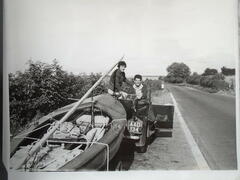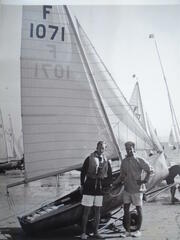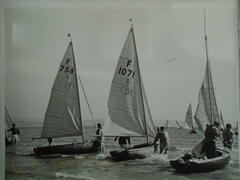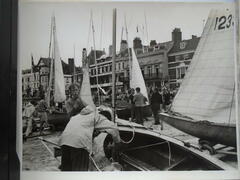The National Firefly Championship – 1957 and 1958
I joined the Royal Navy in 1953. After a year spent at Dartmouth Naval College and on the Cadet Training Ship I was sent to Cambridge to get an Engineering Degree. Half way through my degree course I was promoted to Sub Lieutenant, which entitled me to a uniform allowance of £125. As I did not need to wear uniform for another eighteen months I thought this was an ideal opportunity to buy a boat so I bought a second hand Firefly for £95, which I kept at my home club, Herne Bay, on the North Kent coast. This gave me eighteen months to replenish the uniform budget. I can’t remember whether I did that or whether I finished up as the scruffiest officer in the Navy.
I taught myself to sail in my youth using a borrowed boat but it wasn’t until I arrived at Cambridge that I raced for the first time. I joined the Cambridge University Cruising Club and sailed in their fleet of Fireflies, kept at St Ives, on the River Ouse, about 12 miles out of Cambridge. I found these boats very fast and exciting compared with slower heavier boats I had become used to.
Production of the Firefly started just after World War II in 1946. The boat was designed by Uffa Fox and all the boats were built by Fairey Marine at Hamble, an offshoot of the Fairey Aircraft Company. Two part adhesives, developed during the War, were used in the construction so they were much lighter than earlier wooden boats. All the sails were made by Ratsey and Lapthorn and there was only one design of mast. The boat was therefore a strict one design and boats of any age were competitive. The only change made during my time was to allow terylene sails to replace the cotton ones. The boat was selected for the 1948 Olympics at Torbay as the single handed class. The boat was an instant success as a National Class but it never took off as an International Class.
At the end of my first Academic Year, we went to Itchenor for a week, and I won the Novices Trophy. Two years later, in my final year, I won the University Championship. So, full of confidence, I decided to have a go at the National Championship.
Southend 1957
This was the first Championship I had entered and I had no experience of a large start. The Fireflies at this time attracted a very large entry and there were 155 boats taking part. I had, by this time bought my first car, a 1930 Alvis 12/50. As I did not have a trailer or a towbar we decided to sail to Southend, which was on the other side of the Thames Estuary from Herne Bay. My crew on this occasion was Martin, an old school friend from Primary School days. We loaded the boat up with all our gear and a tent and set off. Before we were a mile offshore we realised our mistake. The heavily loaded boat, instead of riding over the waves, went straight through them and we took a tremendous amount of water on board. We therefore returned to the club and enquired whether anyone had a trailer we could borrow. The Vice Commodore said he had one for sale and I could have it. He said I could pay him later, as soon as I could afford it. One problem solved, but how were we going to tow it.
During the war the Alvis, like most cars, had been laid up in a garage due to the lack of petrol. Unfortunately, when the garage was bombed the back end of the car had been destroyed. A previous owner had constructed a new back end, which served its purpose but lacked authenticity.
Martin said his Dad had an old towbar in his garage, which I could have. I got under the car and found that the homemade back end was a wooden framework to which sheet aluminium was attached. I pulled out a few nails and bent up one of the aluminium sheets to expose the wooden framework. We then attached the towbar to this using fencing wire. It didn’t look very good but it got us to Southend and back.
We arrived in Southend in time for the first race. This was my first experience of sailing in a big fleet and my lack of experience showed. On the first day we made a reasonable start and arrived at the first windward mark somewhere near the front of the fleet, on Port Tack. I met such a mass on boats on Starboard Tack and couldn’t find a single gap to slot into. By the time I had borne away about a quarter of a mile I was very near the back of the fleet.
On about the second day we returned to our tent and found that our gear had been rifled. We didn’t have much of value so we didn’t lose much. Even so, it put us off camping. We went to the Essex Yacht Club, an old ship anchored to the shore, at Leigh On Sea. When we told them our story they offered us some cabins on the ship, which were available at a very reasonable rate, so that is where we spent the rest of our stay.
One thing I remember about the Essex Yacht Club was that, in common with many other clubs at that time, only men were allowed to join. They had just changed their rules to allow lady members but they were restricted to one deck of the ship only. The other deck was men only. In recent years I met the Vice Commodore of the club, when cruising up the East Coast, and told him this story. He said that he thought that wasn’t a bad arrangement and they were thinking of going back to it. I think he was joking.
The Essex Yacht Club was home to the Essex One Design, which in previous years had also been sailed at Herne Bay. Unfortunately, a few years before I joined the club, a fierce storm had wiped out most of the Herne Bay fleet leaving only boat.
I can’t remember much about the sailing in the rest of the week, ie where I came, which means I was somewhere in the middle of the fleet. I have some photos taken by Eileen Ramsay, a professional photographer and the weather looks very overcast but not too windy. It was however a very good social event and provided some useful experience of sailing in a big fleet.
A trip to the Mediterranean
In September 1957, having left Cambridge, I joined a frigate in the Mediterranean. This was the Navy’s way of getting me back into naval routine . Before I left I sold my Alvis as I had nowhere to keep it while away. It fetched £40 which, as I had only paid £45 when I bought it seemed to be a reasonable price. Twenty five years later I very much regretted it because I saw one for sale for £20,000.
Weymouth 1958
After returning from the Mediterranean I was due to spend most of my time at the Naval Electrical School at Fareham, Hampshire. The first thing I did was buy another car. It was a 1934 Austin 10 for which I paid £45. Unusually it was a two seater with a dickie seat. During this time I managed to do plenty of sailing. The navy had a fleet of Fireflies at Portsmouth and I usually raced once a week in an evening race. At weekends I usually returned to Herne Bay and sailed my own boat. The trip from Fareham to Herne Bay was 135 miles which cost me £1 for four gallons of petrol and a pint of beer on the way.
The Championship this year was to be held at Weymouth. John, my regular crew, and I decided to have a go. John and I had been at Grammar School together. Jenny decided she would come along for the trip. She also acted as the photographer, which is why all the photos are of Weymouth and none of Southend. I still had the trailer and it was fairly easy to attach the towbar, which Martin had given me, to the existing brackets at the back of the car.
By the time we had loaded the boat up and got going it was almost midday. It was pretty slow going. The Austin only did 45 mph flat out and with the boat attached and three passengers with their gear we only managed 30mph. By the time we passed Guildford it was getting dark. As we motored along the Hog’s Back we saw another car pull out of a petrol station and follow us. When we arrived at Alton this car reported us to the police saying that he was unable to overtake because we had been swerving about too much. He was probably right because the headlights weren’t very good and there was a bit of play in the steering. However, after the other car had left, we got on well with the copper. He obviously took a shine to Jenny, and she didn’t discourage him. He even helped us to find somewhere to stay the night. The three of us had to sleep in one bed with Jenny in the middle. It was a nice friendly arrangement but we obviously couldn’t get up to anything.
The next morning we set off after breakfast and arrived at Weymouth mid afternoon. The temporary signs directed us to the King’s Statue where we had to unload and leave our boat on the beach with all the others. As we unloaded the Salvation Army band came along and played to us, which was very nice.
During my time on the Training Ship I had learnt some naughty sailors’ songs, one of which, “The Prostitute’s Song” went like this :-
“Me no likey British Sailor,
When Yankee Sailor is ashore,
British Sailor pay one dollar,
Yankee Sailor pay one more,
Yankee Sailor call me “Honey Darling”
British Sailor call me ------- etc.”
I got the biggest shock of my life when the Salvation Army started to play “The Prostitute’s Song”. This was my first trip to Weymouth and I wondered what sort of place I had come to. I only found out later that they had been playing “What a friend we have in Jesus”. Until that time this was a hymn I was not familiar with.
After we had left the boat on the beach, which was very crowded as 168 boats had entered, we went in search of accommodation. We found a guest house in the Abbotsbury Road which was only a twenty minute walk from the beach.
The Championship was arranged as a points series for the Sir Richard Fairey Trophy and a Championship Race on one day for the Sir Ralph Gore trophy. On the Championship Race day we decided to let Jenny have a go at crewing so John stayed ashore. This was the only day in which we did very well. We finished tenth out of 168. The points series was a mixed bag, some good results and some bad. The start and first beat were all important. If you made a mess of that there was no chance in making a recovery. The weather was good on most days. The gate start was beginning to come in at that time and I think some of the races used this start.
Each evening a different club would act as host. I remember the Royal Dorset Yacht Club at that time was on the Promenade. It was a very sociable atmosphere although it could be a scramble to reach the bar with so many competitors. We seemed to drink a lot but we always recovered in time for the racing next day.
At the end of the week we loaded the boat up and got away early in the day. We aimed to do the whole journey back to Herne Bay in one go. Towards the end of the journey it was dark and the dynamo packed up so we used side lights only, hoping the battery would last out. Fortunately I knew the road well and there was not too much traffic.
The End
Towards the end of this year, John announced that he was doing an insurance course. Until this time he had been a meteorologist. After this he intended to emigrate to Bermuda.
I decided, about the same time, to sell the Firefly and build a 505.
I lost track of Martin and Jenny. When we cruised to Bermuda in 2000 we paid John and his family a visit.
Afterthought
It was only later that one of the reasons I had done well with Jenny crewing was because she was much lighter than John. Coming 10th out of 168 was the best result I ever achieved in the Firefly. I did come sixth in the Single Handed Championship but that was out of only 60 boats. There was also another race in which I did extremely well with a girl crew.
At the Cambridge University Cruising Club there were only male members. The female members of the University were not admitted until later. Therefore whenever we raced all the boats were crewed by two men and were therefore all equally overloaded.
I was never took kindly to sailing in such large fleets. To break free and get clear wind after the start you had to be a very good sailor and also have a lot of luck. I still feel that way and much prefer sailing in smaller fleets. Both Southend and Weymouth were excellent social events and getting there in the old cars, which most of had in those days, was a big adventure.
Ernie Rowe
March 2020







